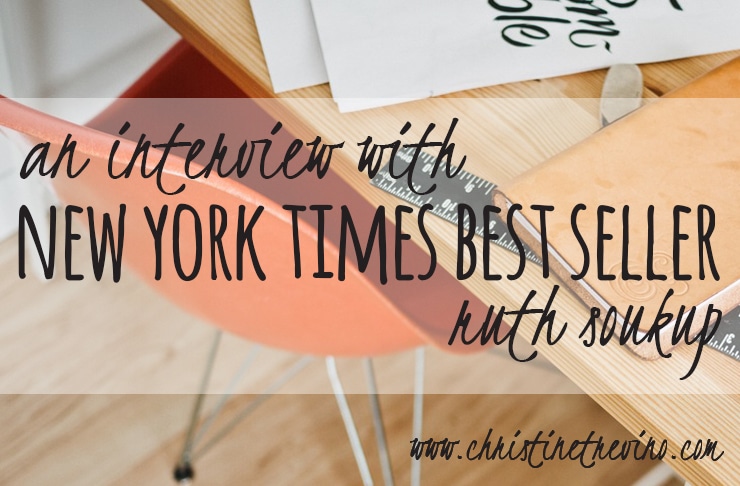An Interview with NY Times Best Seller Ruth Soukup

If you’ve never written a book before and it’s a dream you’d like to see come true, figuring out where to start, or who to ask for help can be a little overwhelming.
Ruth Soukup is the author of self-published Amazon.com #1 Bestseller How To Blog For Profit: Without Selling Your Soul, and the New York Times Best Selling author of traditionally published Living Well Spending Less: 12 Secrets of the Good Life. I am beyond honored to invite you into an interview she agreed to share with us about her publishing journey, the differences between self-publishing and traditional publishing, and her best advice to bloggers who want to become authors.
Sometimes all you need to get started on your own story, is to hear about someone else’s who’s been there. Ruth’s journey will inspire you to own your dreams of publishing and to work hard to make them happen.
Ruth, you have both a self-published and a traditionally published book. Can you share a little about your publishing journey for each?
Traditional publishing is very different from self-publishing in that the process is much, much longer, and it involves a lot more people.
To give you an idea of the timing difference—I met my literary agent and began working on my book proposal for my traditionally-published book in January of 2013. This was the book that would end up being Living Well Spending Less: 12 Secrets of the Good Life, although it started out with a much different title. We finally finished the proposal in May of that year, and my agent began the process of pitching it to different publishers.
It was at that time that I needed a new project to soak up all the nervous energy I was feeling, so I decided to start working on a different book idea, one that I was planning to self-publish, called How to Blog for Profit (Without Selling Your Soul). By that time I had a lot of readers and a lot of friends asking me what I was doing to grow my blog, so I figured, since I didn’t normally write about blogging on my blog, that I would just write it all down in an eBook and be done with it.
It took me just under 3 months to write the manuscript for How to Blog for Profit, and right about the time I was finishing it, I got an offer from Zondervan for Living Well Spending Less, in late July 2013. I spent the month of August that year editing and formatting How to Blog for Profit for release on Kindle, and then launched it in September. It was instant hit, which really surprised me!
I worked with my editors for several months, then turned in my manuscript for Living Well Spending Less in January, 2014 and from there spent a lot of time waiting! There is all sorts of behind-the-scenes stuff that happens with traditionally published books that the author has nothing to do with, so it was during that time, around June of 2014, that I decided to update How to Blog for Profit and also release it in paperback as an expanded 2nd Edition.
My team and I started working on our marketing plan for Living Well Spending Less in the summer of 2014, which included developing 2 sets of video challenges based on the book that would be distributed via email. We also created a set of preorder bonuses, and worked closely with the Zondervan team to develop advertising and PR campaigns. I learned that a first time author is basically the bottom of the food chain in the publishing world and you really have to work to prove yourself, no matter how “successful” you might be in the blogging world! Luckily, our plan was pretty solid, and by the time the book finally launched, on December 30th, 2014 (almost 2 years from when I started working on it!) all the planning really fell into place.
The pros of self publishing are that it is much, much faster to get a book to market, and also much easier—you don’t need an agent or a book deal. It can also be much more profitable, since the bulk of the profits go to you and not the publisher. The cons are that the process can be a little overwhelming for some people, and that it doesn’t always have the same “klout” that a traditionally published book can have. A self-published book won’t normally be distributed in bookstores either, although since Amazon is the world’s largest bookseller, that is not the end of the world!
The pros of traditional publishing are the credibility that it can add, as well as the sense of legitimacy and the quality of the finished product. There is a LOT of editing that happens to make sure your book is well written and mistake-free. There is also a sense of peace that can come from having a publisher help you market and sell your book, although authors should be careful about thinking a publisher will do all the work—they won’t! The con is that the process is SLOW and somewhat antiquated. Traditional publishing is very behind the times and the inefficiency, especially when you are used to being your own boss and the instant nature of the Internet, can be frustrating. There are also a lot more people to work with, which brings more opportunities for personalities to clash.
How did you find your agent?
I met my agent Esther Fedorkevich at SheSpeaks. When I met her, she warned me that she was not the type of agent to hold my hand, and she certainly hasn’t. That said, she did secure a fantastic book deal for me. I think this is definitely something to consider when looking for an agent—it is important find someone who can get you a great deal, but you also want someone who really believes in you and your message. Book writing is HARD—probably the hardest thing I have ever done. I am a pretty self-motivated person, so I didn’t think I needed a cheerleader, but looking back, I probably could have benefited from a few more pep talks along the way!
How did you select the publishing houses for your books?
I selected Zondervan for a couple of reasons. First, I absolutely loved the acquisitions editor, Carolyn McCready. She and I spoke on the phone before they made the offer and I felt a real connection with her. She has been absolutely a joy to work with. Also, the Zondervan offer was a 2 book deal and I felt like they had a better vision for both books.
I went with KDP Select because they make publishing really easy, first of all, and also because the royalty rate is much higher if you agree to publish exclusively for Kindle in the first few months.
What do you wish you knew at the beginning of your publishing journey that you know now?
I wish I would have known how emotionally draining the process of writing a book can be. It is very different from blog writing, and there were SO many moments of self-doubt and self-loathing. I was convinced I couldn’t write, and that everything I had written was garbage. Now I know that is completely normal and part of the process. Every author I know goes through the exact same thing!
What do you hope will be different about your next book project?
I think I am better prepared now for what it takes and for how long the process takes. After going through a big launch I am also more aware now of how important it is to think about marketing during the writing process.
How do you balance writing content for your blog and writing content for your books?
For the blog I work from an editorial calendar, and my team and I try to work several months in advance. It is definitely a team effort, with each of us contributing different parts of each post. I usually set aside a certain amount of time each week to work on upcoming content, and I always do final edits just before the post is published.
Book writing is a little different. After doing a detailed outline of each chapter, I usually try to make a schedule for the project that breaks it down into manageable bites. Then I will usually reserve the first couple of hours of my day for writing, and try to write at least 500-1000 words per day.
What advice would you offer to bloggers hoping to become authors?
Build your platform! The stronger your platform, the better chance you will have of finding an agent and getting a book deal. Publishers will barely consider any author that does not have an established platform these days. The good news is that your platform does not need to be as big as you might think. If you’ve got more than 50,000 page views per month, plus a decent presence on Facebook, Twitter, or Instagram you will be doing well. Going to writing conferences to meet with publishers and agents is a really good idea too.
About Ruth
 Ruth Soukup believes with all her heart that a life well lived is not so much about what we have, but who we are. Her mission is to empower and inspire women everywhere to seek—and find—the Good Life. Through her popular blog, Living Well Spending Less, which reaches more than one million women each month, she encourages her readers to follow their dreams and reach their goals, sharing easy-to-implement tips and strategies for saving time and money while focusing on the things that matter most. Her practical advice has been featured in numerous publications and news programs, including Women’s Day, Redbook, ALL YOU and The Daily Buzz.
Ruth Soukup believes with all her heart that a life well lived is not so much about what we have, but who we are. Her mission is to empower and inspire women everywhere to seek—and find—the Good Life. Through her popular blog, Living Well Spending Less, which reaches more than one million women each month, she encourages her readers to follow their dreams and reach their goals, sharing easy-to-implement tips and strategies for saving time and money while focusing on the things that matter most. Her practical advice has been featured in numerous publications and news programs, including Women’s Day, Redbook, ALL YOU and The Daily Buzz.
* This post contains Amazon Affiliate links. Purchasing items through these links helps support this site and keep content free. For more information please see my disclosure page.